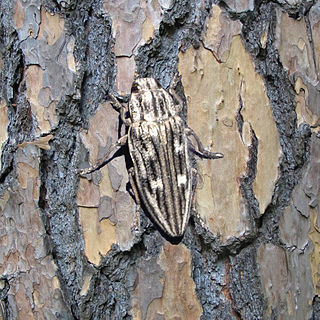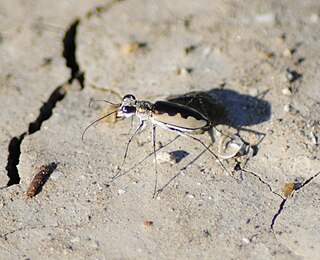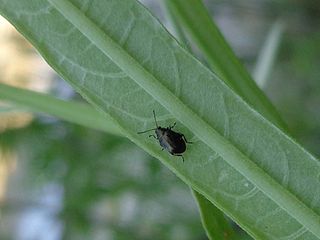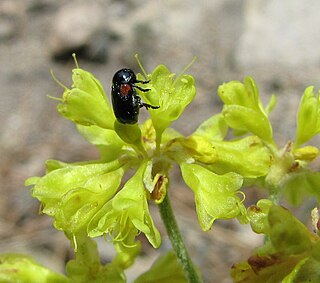Related Research Articles

John Lawrence LeConte was an American entomologist, responsible for naming and describing approximately half of the insect taxa known in the United States during his lifetime, including some 5,000 species of beetles. He was recognized as the foremost authority on North American beetles during his career, and has been described as "the father of American beetle study".

Buprestis is a genus of beetles in the tribe Buprestini, the jewel beetles. As of 2011 there were 78 described species distributed across most of the world's biogeographic realms except parts of Africa and Antarctica.

Hygrotus is a genus of beetle in family Dytiscidae. It contains two subgenera and about 70 species, including:

Lepturinae, the lepturine beetles, is a subfamily of the longhorn beetle family (Cerambycidae), containing about 150 genera worldwide. This lineage is most diverse in the Northern Hemisphere. Until recently the subfamily Necydalinae was included within the lepturines, but this has been recently recognized as a separate subfamily. Nine tribes are usually recognized today, with a tenth, Caraphiini, created in 2016. A few genera are of uncertain placement within the subfamily.

Altica is a large genus of flea beetles in the subfamily Galerucinae, with about 300 species, distributed nearly worldwide. The genus is best represented in the Neotropical realm, well represented in the Nearctic and Palearctic, but occurs also in the Afrotropic, Indomalaya, and Australasia. The species are similar to each other, small metallic blue-green-bronze beetles, often distinguished from each other only by the aedeagus. The species of Altica, both as larvae and as adults, are phytophagous, feeding on plant foliage of various food plant taxa, specific for each Altica species. Onagraceae and Rosaceae are the dominant host plant families for Holarctic species. The adult Altica beetles are able to jump away when approached.
Vrilletta californica is a species of beetle in the family Ptinidae.
Brachysomida bivittata is the species of the Lepturinae subfamily in longhorn beetle family. The beetle is distributed in Canada, and Nebraska, United States.

Chalcophora is a genus of beetles in the family Buprestidae, containing the following living species:

Dicerca is a genus of beetles in the family Buprestidae. It contains the following species:

Polycesta is a genus of "jewel beetles" in the subfamily Polycestinae, containing the following species:

Eunota, also known as the saline tiger beetles, is a genus of beetles in the family Cicindelidae first described by Émile Rivalier in 1954. They are found in the United States and Mexico

Chaetocnema is a genus of flea beetles in the family Chrysomelidae. There are some 470 described species worldwide.

Brachysomida is a genus of beetles in the family Cerambycidae, containing the following species:

Neoclytus is a genus of beetles in the family Cerambycidae. They measure 4-20 mm. There are 93 species in the New World.

Calligrapha is a genus of large American Chrysomelinae of imprecise taxonomic boundaries. Most species occur in Central and South America.
Triplax californica is a species of pleasing fungus beetle in the family Erotylidae. It is found in North America.

Systena is a genus of flea beetles in the family Chrysomelidae. There are about 90 described species, found in the New World, mostly in the Neotropics.

Saxinis saucia is a species of case-bearing leaf beetle in the family Chrysomelidae. It is found in Central America and North America.
References
- 1 2 Zicha, Ondrej. "BioLib: Biological library". www.biolib.cz.
- ↑ "Species Brachysomida californica". bugguide.net.
- ↑ Steven W. Lingafelter; Eugenio H. Nearns; Gérard L. Tavakilian; Miguel A. Monné; Michael Biondi (2014). Longhorned Woodboring Beetles (Coleoptera: Cerambycidae and Disteniidae). Washington, D.C.: Smithsonian Institution Scholarly Press. ISBN 978-1-935623-40-3. LCCN 2014005388.